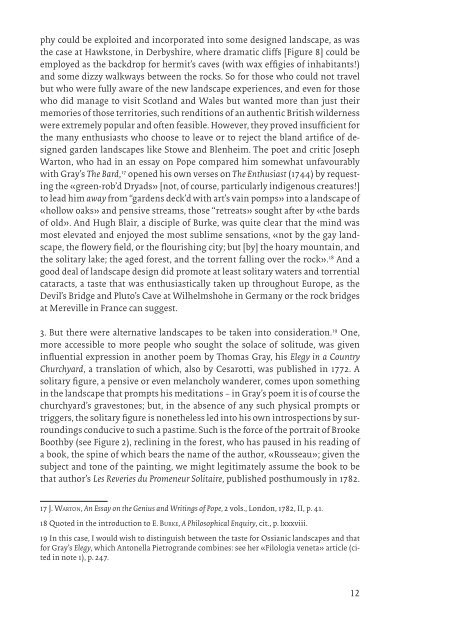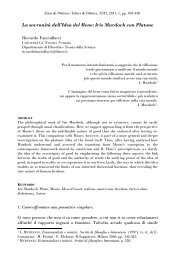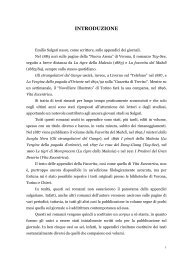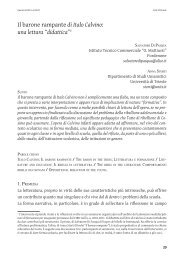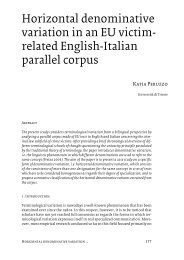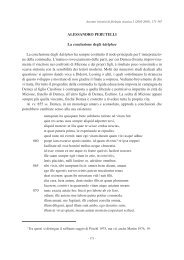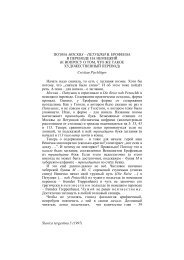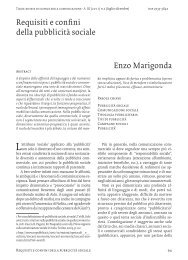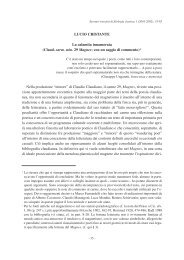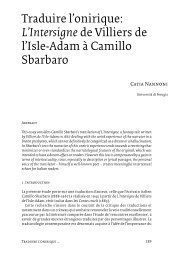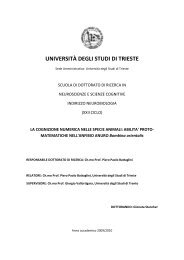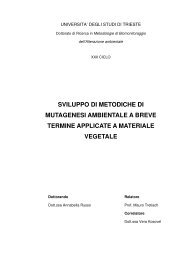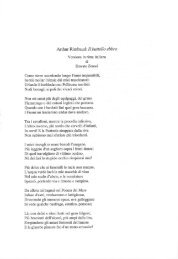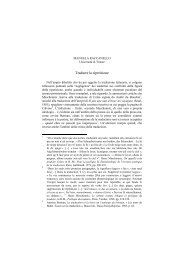Melchiorre Cesarotti e le trasformazioni del paesaggio ... - OpenstarTs
Melchiorre Cesarotti e le trasformazioni del paesaggio ... - OpenstarTs
Melchiorre Cesarotti e le trasformazioni del paesaggio ... - OpenstarTs
You also want an ePaper? Increase the reach of your titles
YUMPU automatically turns print PDFs into web optimized ePapers that Google loves.
phy could be exploited and incorporated into some designed landscape, as was<br />
the case at Hawkstone, in Derbyshire, where dramatic cliffs [Figure 8] could be<br />
employed as the backdrop for hermit’s caves (with wax effigies of inhabitants!)<br />
and some dizzy walkways between the rocks. So for those who could not travel<br />
but who were fully aware of the new landscape experiences, and even for those<br />
who did manage to visit Scotland and Wa<strong>le</strong>s but wanted more than just their<br />
memories of those territories, such renditions of an authentic British wilderness<br />
were extremely popular and often feasib<strong>le</strong>. However, they proved insufficient for<br />
the many enthusiasts who choose to <strong>le</strong>ave or to reject the bland artifice of designed<br />
garden landscapes like Stowe and B<strong>le</strong>nheim. The poet and critic Joseph<br />
Warton, who had in an essay on Pope compared him somewhat unfavourably<br />
with Gray’s The Bard, 17 opened his own verses on The Enthusiast (1744) by requesting<br />
the «green-rob’d Dryads» [not, of course, particularly indigenous creatures!]<br />
to <strong>le</strong>ad him away from “gardens deck’d with art’s vain pomps» into a landscape of<br />
«hollow oaks» and pensive streams, those “retreats» sought after by «the bards<br />
of old». And Hugh Blair, a discip<strong>le</strong> of Burke, was quite c<strong>le</strong>ar that the mind was<br />
most e<strong>le</strong>vated and enjoyed the most sublime sensations, «not by the gay landscape,<br />
the flowery field, or the flourishing city; but [by] the hoary mountain, and<br />
the solitary lake; the aged forest, and the torrent falling over the rock». 18 And a<br />
good deal of landscape design did promote at <strong>le</strong>ast solitary waters and torrential<br />
cataracts, a taste that was enthusiastically taken up throughout Europe, as the<br />
Devil’s Bridge and Pluto’s Cave at Wilhelmshohe in Germany or the rock bridges<br />
at Merevil<strong>le</strong> in France can suggest.<br />
3. But there were alternative landscapes to be taken into consideration. 19 One,<br />
more accessib<strong>le</strong> to more peop<strong>le</strong> who sought the solace of solitude, was given<br />
influential expression in another poem by Thomas Gray, his E<strong>le</strong>gy in a Country<br />
Churchyard, a translation of which, also by <strong>Cesarotti</strong>, was published in 1772. A<br />
solitary figure, a pensive or even melancholy wanderer, comes upon something<br />
in the landscape that prompts his meditations – in Gray’s poem it is of course the<br />
churchyard’s gravestones; but, in the absence of any such physical prompts or<br />
triggers, the solitary figure is nonethe<strong>le</strong>ss <strong>le</strong>d into his own introspections by surroundings<br />
conducive to such a pastime. Such is the force of the portrait of Brooke<br />
Boothby (see Figure 2), reclining in the forest, who has paused in his reading of<br />
a book, the spine of which bears the name of the author, «Rousseau»; given the<br />
subject and tone of the painting, we might <strong>le</strong>gitimately assume the book to be<br />
that author’s Les Reveries du Promeneur Solitaire, published posthumously in 1782.<br />
17 J. Warton, An Essay on the Genius and Writings of Pope, 2 vols., London, 1782, II, p. 41.<br />
18 uoted in the introduction to E. Burke, A Philosophical Enquiry, cit., p. lxxxviii.<br />
19 In this case, I would wish to distinguish between the taste for Ossianic landscapes and that<br />
for Gray’s E<strong>le</strong>gy, which Antonella Pietrogrande combines: see her «Filologia veneta» artic<strong>le</strong> (cited<br />
in note 1), p. 247.<br />
12


